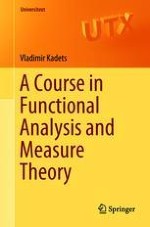2018 | OriginalPaper | Chapter
12. Hilbert Spaces
Author : Vladimir Kadets
Published in: A Course in Functional Analysis and Measure Theory
Publisher: Springer International Publishing
Activate our intelligent search to find suitable subject content or patents.
Select sections of text to find matching patents with Artificial Intelligence. powered by
Select sections of text to find additional relevant content using AI-assisted search. powered by

